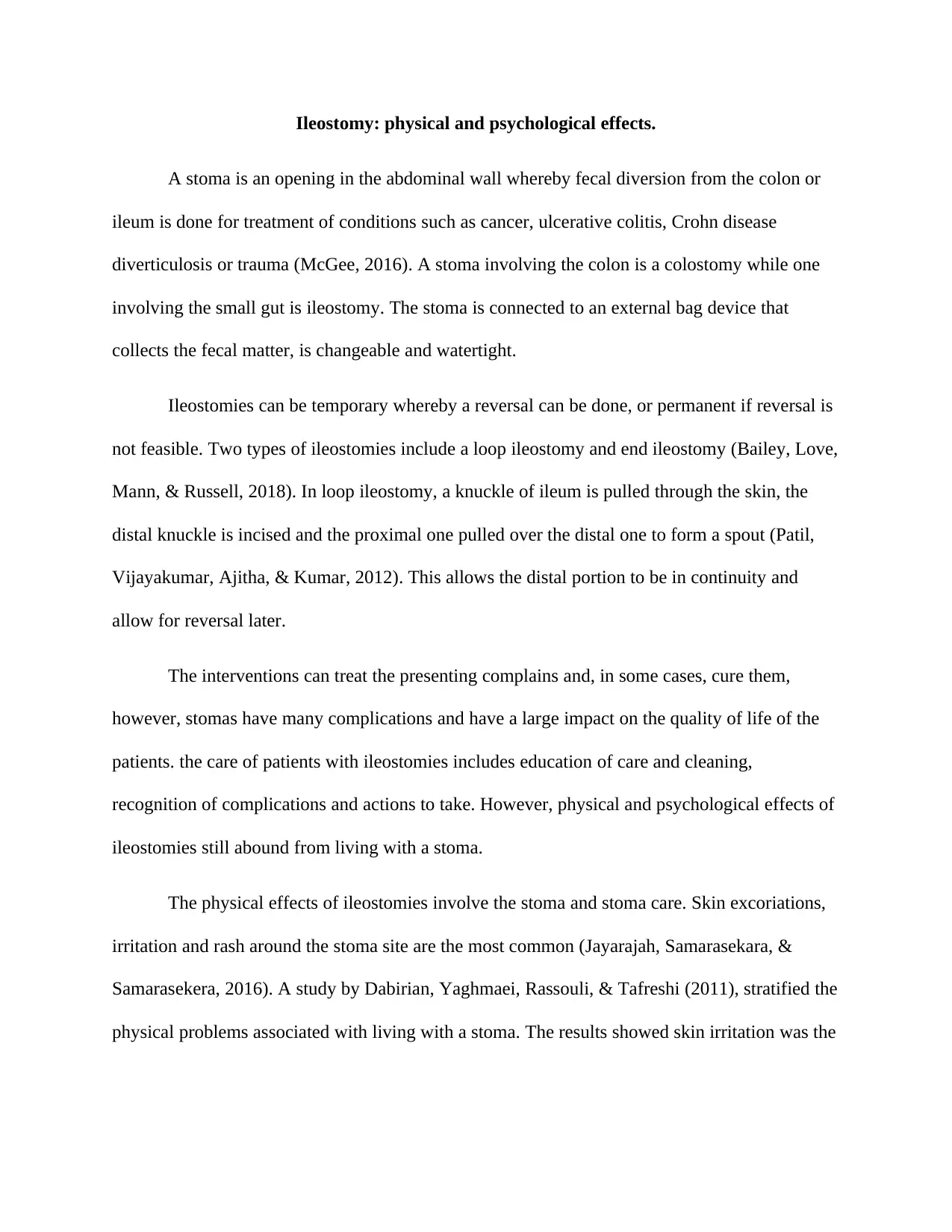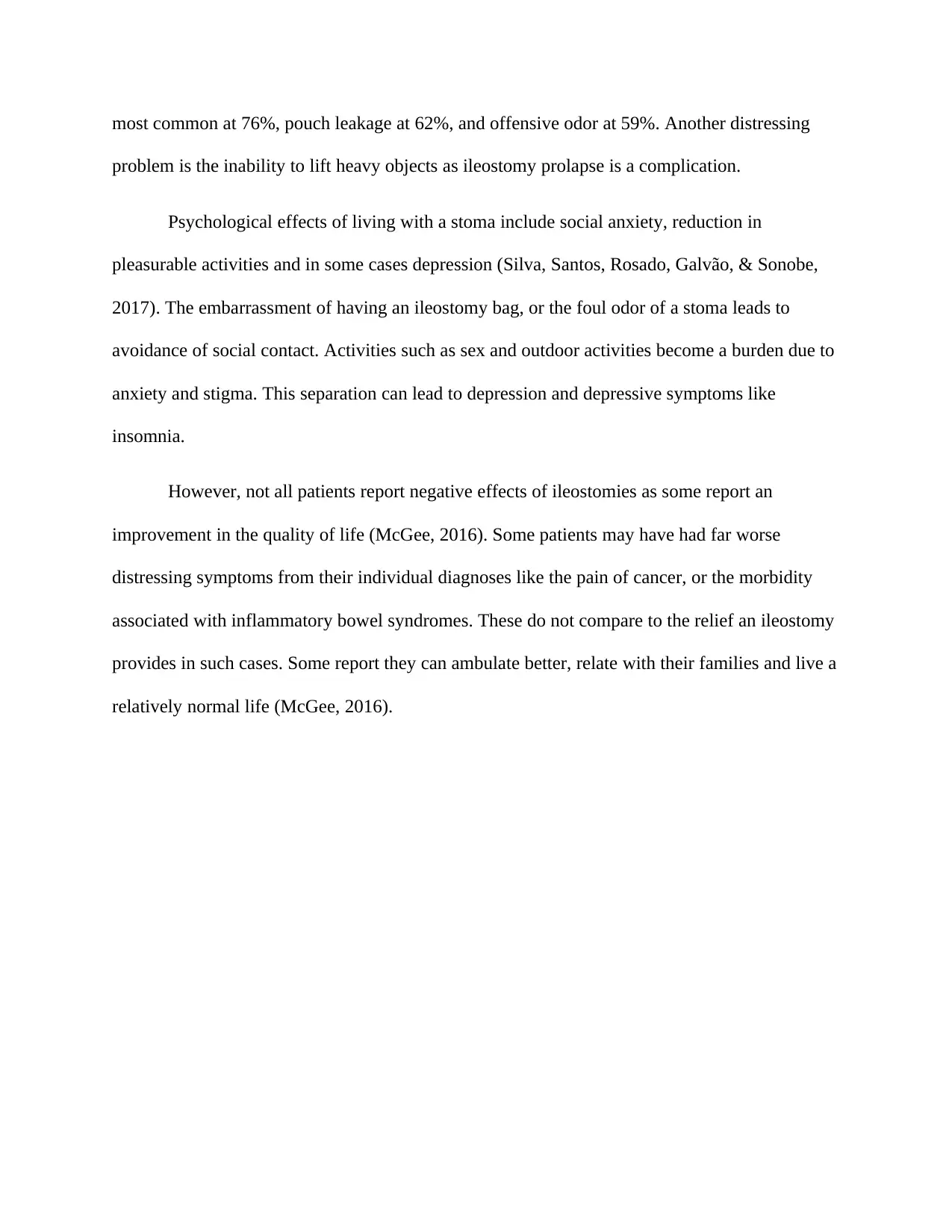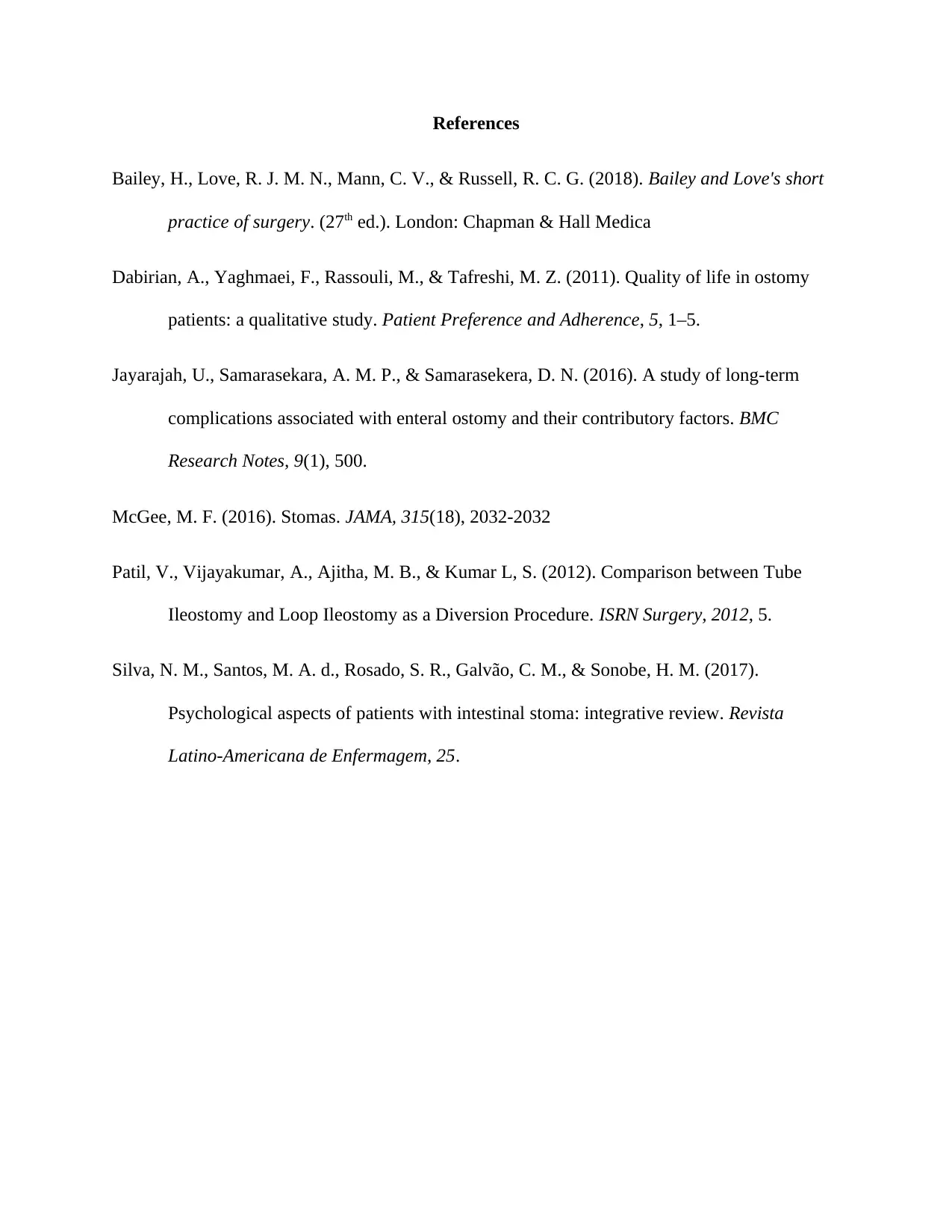Ileostomy: Physical and Psychological Effects
VerifiedAdded on 2023/06/12
|3
|783
|112
AI Summary
This article discusses the physical and psychological effects of ileostomy, including skin irritation, pouch leakage, social anxiety, and depression. It also mentions the positive impact of ileostomy on some patients' quality of life. The article provides information on the types of ileostomy, complications, and care for patients with ileostomy.
Contribute Materials
Your contribution can guide someone’s learning journey. Share your
documents today.

Ileostomy: physical and psychological effects.
A stoma is an opening in the abdominal wall whereby fecal diversion from the colon or
ileum is done for treatment of conditions such as cancer, ulcerative colitis, Crohn disease
diverticulosis or trauma (McGee, 2016). A stoma involving the colon is a colostomy while one
involving the small gut is ileostomy. The stoma is connected to an external bag device that
collects the fecal matter, is changeable and watertight.
Ileostomies can be temporary whereby a reversal can be done, or permanent if reversal is
not feasible. Two types of ileostomies include a loop ileostomy and end ileostomy (Bailey, Love,
Mann, & Russell, 2018). In loop ileostomy, a knuckle of ileum is pulled through the skin, the
distal knuckle is incised and the proximal one pulled over the distal one to form a spout (Patil,
Vijayakumar, Ajitha, & Kumar, 2012). This allows the distal portion to be in continuity and
allow for reversal later.
The interventions can treat the presenting complains and, in some cases, cure them,
however, stomas have many complications and have a large impact on the quality of life of the
patients. the care of patients with ileostomies includes education of care and cleaning,
recognition of complications and actions to take. However, physical and psychological effects of
ileostomies still abound from living with a stoma.
The physical effects of ileostomies involve the stoma and stoma care. Skin excoriations,
irritation and rash around the stoma site are the most common (Jayarajah, Samarasekara, &
Samarasekera, 2016). A study by Dabirian, Yaghmaei, Rassouli, & Tafreshi (2011), stratified the
physical problems associated with living with a stoma. The results showed skin irritation was the
A stoma is an opening in the abdominal wall whereby fecal diversion from the colon or
ileum is done for treatment of conditions such as cancer, ulcerative colitis, Crohn disease
diverticulosis or trauma (McGee, 2016). A stoma involving the colon is a colostomy while one
involving the small gut is ileostomy. The stoma is connected to an external bag device that
collects the fecal matter, is changeable and watertight.
Ileostomies can be temporary whereby a reversal can be done, or permanent if reversal is
not feasible. Two types of ileostomies include a loop ileostomy and end ileostomy (Bailey, Love,
Mann, & Russell, 2018). In loop ileostomy, a knuckle of ileum is pulled through the skin, the
distal knuckle is incised and the proximal one pulled over the distal one to form a spout (Patil,
Vijayakumar, Ajitha, & Kumar, 2012). This allows the distal portion to be in continuity and
allow for reversal later.
The interventions can treat the presenting complains and, in some cases, cure them,
however, stomas have many complications and have a large impact on the quality of life of the
patients. the care of patients with ileostomies includes education of care and cleaning,
recognition of complications and actions to take. However, physical and psychological effects of
ileostomies still abound from living with a stoma.
The physical effects of ileostomies involve the stoma and stoma care. Skin excoriations,
irritation and rash around the stoma site are the most common (Jayarajah, Samarasekara, &
Samarasekera, 2016). A study by Dabirian, Yaghmaei, Rassouli, & Tafreshi (2011), stratified the
physical problems associated with living with a stoma. The results showed skin irritation was the
Secure Best Marks with AI Grader
Need help grading? Try our AI Grader for instant feedback on your assignments.

most common at 76%, pouch leakage at 62%, and offensive odor at 59%. Another distressing
problem is the inability to lift heavy objects as ileostomy prolapse is a complication.
Psychological effects of living with a stoma include social anxiety, reduction in
pleasurable activities and in some cases depression (Silva, Santos, Rosado, Galvão, & Sonobe,
2017). The embarrassment of having an ileostomy bag, or the foul odor of a stoma leads to
avoidance of social contact. Activities such as sex and outdoor activities become a burden due to
anxiety and stigma. This separation can lead to depression and depressive symptoms like
insomnia.
However, not all patients report negative effects of ileostomies as some report an
improvement in the quality of life (McGee, 2016). Some patients may have had far worse
distressing symptoms from their individual diagnoses like the pain of cancer, or the morbidity
associated with inflammatory bowel syndromes. These do not compare to the relief an ileostomy
provides in such cases. Some report they can ambulate better, relate with their families and live a
relatively normal life (McGee, 2016).
problem is the inability to lift heavy objects as ileostomy prolapse is a complication.
Psychological effects of living with a stoma include social anxiety, reduction in
pleasurable activities and in some cases depression (Silva, Santos, Rosado, Galvão, & Sonobe,
2017). The embarrassment of having an ileostomy bag, or the foul odor of a stoma leads to
avoidance of social contact. Activities such as sex and outdoor activities become a burden due to
anxiety and stigma. This separation can lead to depression and depressive symptoms like
insomnia.
However, not all patients report negative effects of ileostomies as some report an
improvement in the quality of life (McGee, 2016). Some patients may have had far worse
distressing symptoms from their individual diagnoses like the pain of cancer, or the morbidity
associated with inflammatory bowel syndromes. These do not compare to the relief an ileostomy
provides in such cases. Some report they can ambulate better, relate with their families and live a
relatively normal life (McGee, 2016).

References
Bailey, H., Love, R. J. M. N., Mann, C. V., & Russell, R. C. G. (2018). Bailey and Love's short
practice of surgery. (27th ed.). London: Chapman & Hall Medica
Dabirian, A., Yaghmaei, F., Rassouli, M., & Tafreshi, M. Z. (2011). Quality of life in ostomy
patients: a qualitative study. Patient Preference and Adherence, 5, 1–5.
Jayarajah, U., Samarasekara, A. M. P., & Samarasekera, D. N. (2016). A study of long-term
complications associated with enteral ostomy and their contributory factors. BMC
Research Notes, 9(1), 500.
McGee, M. F. (2016). Stomas. JAMA, 315(18), 2032-2032
Patil, V., Vijayakumar, A., Ajitha, M. B., & Kumar L, S. (2012). Comparison between Tube
Ileostomy and Loop Ileostomy as a Diversion Procedure. ISRN Surgery, 2012, 5.
Silva, N. M., Santos, M. A. d., Rosado, S. R., Galvão, C. M., & Sonobe, H. M. (2017).
Psychological aspects of patients with intestinal stoma: integrative review. Revista
Latino-Americana de Enfermagem, 25.
Bailey, H., Love, R. J. M. N., Mann, C. V., & Russell, R. C. G. (2018). Bailey and Love's short
practice of surgery. (27th ed.). London: Chapman & Hall Medica
Dabirian, A., Yaghmaei, F., Rassouli, M., & Tafreshi, M. Z. (2011). Quality of life in ostomy
patients: a qualitative study. Patient Preference and Adherence, 5, 1–5.
Jayarajah, U., Samarasekara, A. M. P., & Samarasekera, D. N. (2016). A study of long-term
complications associated with enteral ostomy and their contributory factors. BMC
Research Notes, 9(1), 500.
McGee, M. F. (2016). Stomas. JAMA, 315(18), 2032-2032
Patil, V., Vijayakumar, A., Ajitha, M. B., & Kumar L, S. (2012). Comparison between Tube
Ileostomy and Loop Ileostomy as a Diversion Procedure. ISRN Surgery, 2012, 5.
Silva, N. M., Santos, M. A. d., Rosado, S. R., Galvão, C. M., & Sonobe, H. M. (2017).
Psychological aspects of patients with intestinal stoma: integrative review. Revista
Latino-Americana de Enfermagem, 25.
1 out of 3
Related Documents
Your All-in-One AI-Powered Toolkit for Academic Success.
+13062052269
info@desklib.com
Available 24*7 on WhatsApp / Email
![[object Object]](/_next/static/media/star-bottom.7253800d.svg)
Unlock your academic potential
© 2024 | Zucol Services PVT LTD | All rights reserved.
